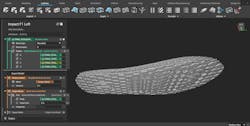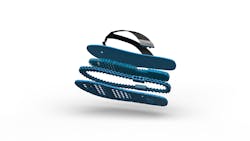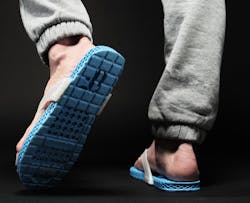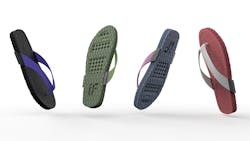Software helps new shoe company gain running start
Problem: Traditional design software proved too clunky and slow for a business devoted to selling made-to-order flip-flops built with complex lattice structures and available in millions of permutations.
Solution: Designed for iterative manufacturing, Topology’s nTop software handles design variants with ease.
By Karen Hanna
If a fairy godmother hadn’t created Cinderella’s distinctive slippers, a 3-D printer might have.
A new shoe company formed to create the fairytale perfect fit is launching this spring, with flip-flops that can be customized in nine different ways, producing more than 10 million permutations.
It’s not magic, but nTop — a software package that is powering one man’s dream to create an environmentally conscious fashion splash.
“I really thought that there was an opportunity to [create] custom footwear, and one of the initial thoughts was to do this in an eco-focused way, doing it on demand and trying to localize production,” said Craig DeMerit, who founded his Impact Footwear online store after 20-plus years heading up companies that sell jewelry and women’s accessories. One year after striking out on his own, he plans to begin delivering shoes in time for this year’s beach season.
But, he said, the structures proved a demanding ask from traditional design software.
“The first solution that we went with … it took hours for a lot of these manipulations to occur, it was extremely CPU-intensive and slow, and very frustrating to work with, fairly limiting into how well it could manipulate the initial object that we had established. And then the ability to automate that was fairly complex,” he said.
The software had to be just right—a program that could create lattices and other designs quickly, then translate them for many models of 3-D printers. DeMerit’s not committed to any particular printer—he wants the freedom to produce products on whatever technology is available—but believes selective-laser-sintering is the most suitable process. With the ability to work withImpact Footwear’s pairing of printers with nTop provides one example of what is possible as 3-D printing evolves from novelty technology to large-volume production of individualized products.
“If you think about it, the flip-flop is the same as a spinal implant,” said Duann Scott, the VP of business development and strategic partnerships for nTopology, which makes nTop.
Manufacturers in many high-tech fields, including the medical industry, use nTop, Scott said, and they enjoy the same advantage from it as DeMerit — on-demand customizability.
“The spinal implant, it's different for a child than for a 6-foot-3 man. ... Each one is different, but they all have the same set of requirements as having the need to deal with stress, but the amount of stress going on a child's implant versus a huge man’s is very, very different,” he said. “And so our medical customers will make the same sort of recipe up, then they'd have 36 variants, and create them all, and then they have something for every sort of customer they need. The same is true for a flip-flop, it's just a different requirement.”
From your fingertips to your feet
Impact Footwear’s websitefeatures a configurator that allows users to select their preferences on variables such as outsole style, insole style and size. NeedPrice alone makes the K unique — they're $125 a pair.
DeMerit pointed out that the shoes are designed to last longer than your standard beach fare. And because the soles are recyclable, he hopes they’ll have a more dignified end than many plastic products. Returning to the beach as ocean plastics isn’t in the plans.
“We do think there's a customer out there who wants to make their own product, have something custom to them, and is also intrigued with the idea that it can use materials that can be circular, and be done in a way where you're not building [something] for landfills, you're not building inventory,” DeMerit said.
Impact Footwear still is testing three materials for its soles. The straps are manufactured and attached separately, but the design allows them to be removed and easily swapped out; in the future, they might be made from reground soles.
“The three materials we have been testing all can be reground and repurposed for other recyclable items, such as packaging and injection molding,” he said.
In his quest to find an engine with enough processing horsepower for so much customization, DeMerit visited a trade show, where he met nTopology representatives. He was impressed enough with the technology to call the company frequently, earning the title “Crazy Flip-Flop Guy.” No matter. He had found a solution: Software that can produce very quick iterations and work with most 3-D printers.
“What we've built today is a fully automated solution where a user can go on the front end to a 3-D configurator that we've built with some software, make all of their choices, store variables and then bring those variables over as inputs to a notebook in nTop that basically drives the full automation,” he said “We can basically script this out completely without a human involved to generate a final STL file that gets sent over to a service provider.”
Scott described nTop as a programming language that can work on its own or alongside CAD programs. It handles iterative design with ease. “Complexity doesn't change the time it takes to do the equation, like it's basically 26 milliseconds for geometry the size of your fingertip, or 28 milliseconds for a geometry the size of a house. There's no scale issue in the mathematic equation, it's just adding a number to the equation,” Scott said.
Unlike the first program DeMerit considered, nTop doesn’t get bogged down by all the variations.
“So, if you want to make 100 variants of the flip-flop, that’s completely OK because once you’ve got that setup made, you just change those variables, and then you have the 100 variants,” Scott said. “You don't have to start from scratch each time and make sure the part’s going to work, because you know it’s going to work, because it's sort of programmed in like you’re programming a computer. You're programming geometry.”
While high-end customers, like the defense and aerospace industries, have been among the first to deploy the power of 3-D printing, they won’t be the last, said Scott, who sees a future for the technology in consumer products.
DeMerit, too, is looking ahead — he’s already thinking about other kinds of shoes.
“Our goal is to take this to other silhouettes and styles. But it starts with having success,” he said.
Software advances can help customers realize 3-D printing’s full potential.
“Our software is made for solving the problems that traditional software cannot,” Scott said.
Karen Hanna, associate editor
Contact:
Impact Footwear, Pasadena, Calif., https://impactfootwear.com
nTopology, New York, 917-983-9257, https://ntopology.com
About the Author
Karen Hanna
Senior Staff Reporter
Senior Staff Reporter Karen Hanna covers injection molding, molds and tooling, processors, workforce and other topics, and writes features including In Other Words and Problem Solved for Plastics Machinery & Manufacturing, Plastics Recycling and The Journal of Blow Molding. She has more than 15 years of experience in daily and magazine journalism.




